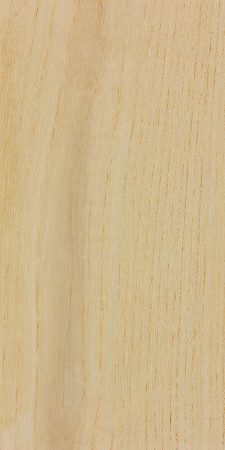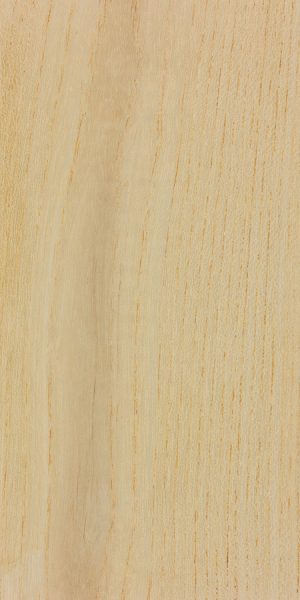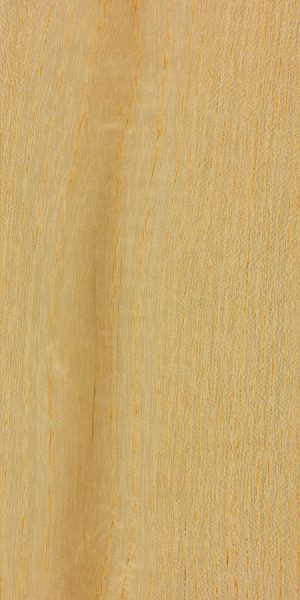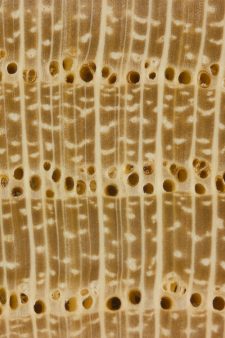Common Name(s): Ailanthus, tree of heaven, Chinese sumac
Scientific Name: Ailanthus altissima
Distribution: Native to China; widely naturalized worldwide
Tree Size: 65-100 ft (20-30 m) tall,
2-3 ft (.6-1 m) trunk diameter
Average Dried Weight: 37.1 lbs/ft3 (600 kg/m3)
Specific Gravity (Basic, 12% MC): .44, .60
Janka Hardness: 1,420 lbf (6,300 N)
Modulus of Rupture: 11,060 lbf/in2 (76.2 MPa)
Elastic Modulus: 1,623,000 lbf/in2 (11,19 GPa)
Crushing Strength: 6,680 lbf/in2 (46.1 MPa)
Shrinkage: Radial: 6.1%, Tangential: 10.8%,
Volumetric: 17.1%, T/R Ratio: 1.8
Color/Appearance: Ranges from a pale yellow to light brown, sometimes with brighter yellowish or olive-hued streaks. Overall appearance is similar to ash.
Grain/Texture: Has an open, porous texture and a moderate natural luster.
Rot Resistance: No data available; reported to have good insect resistance.
Workability: Easy to work with hand and machine tools. Turns, glues, stains, and finishes well.
Odor: No characteristic odor.
Allergies/Toxicity: Ailanthus has been reported to cause skin irritation. See the articles Wood Allergies and Toxicity and Wood Dust Safety for more information.
Pricing/Availability: No data available.
Sustainability: This wood species is not listed in the CITES Appendices or on the IUCN Red List of Threatened Species. In many locations it’s considered to be an invasive or pest species.
Common Uses: Cabinetry, turned objects, and paper (pulpwood).
Comments: Once viewed as an honored ornamental tree in China, resulting in it becoming widely naturalized throughout much of the world during the 19th century. Today, ailanthus’ quick growth and hardiness have proved to be overwhelming for many ecosystems, and it is widely viewed as an invasive species.
The tree is commonly called tree of heaven—from the Ambonese word aylanto (rendered ailanthus in Latin). The name is in reference to the great heights of the tree (helped by a very robust grow rate). One Ailanthus species native to Melasia, Ailanthus integrifolia, can reach heights up to 200 feet (60 meters) and may be the original source for the common name, aylanto—tree of heaven.
Images: Drag the slider up/down to toggle between raw and finished wood. A special thanks to Adam Cottrill for providing the turned photo of this wood species.
Identification: See the article on Hardwood Anatomy for definitions of endgrain features.
Porosity: ring porous
Arrangement: earlywood in single broken row, latewood in diagonal/tangential arrangement
Vessels: very large earlywood pores, small to medium latewood pores
Parenchyma: vasicentric, winged, and confluent in latewood
Rays: medium to wide; wide spacing
Lookalikes/Substitutes: Can be confused with species of ash (Fraxinus genus) as well as sassafras (Sassafras albidum). Both of these lookalikes can be distinguished from ailanthus by the ray width. Ailanthus has wider rays that are generally visible even without magnification, while the others have narrower rays that can’t be seen clearly without magnification.
Another less common wood that bears an even closer resemblance to ailanthus is hackberry (Celtis occidentalis). Hackberry’s lighter colored sapwood (excluding its darker heartwood) matches in both appearance and anatomy. However, hackberry’s earlywood pores are in rows at least two to three pores wide, while ailanthus tends to have its earlywood pores in a row more or less only one pore wide.
Notes: None.
Related Content:













I harvested some from a freshly cut tree back in 2021 and cut it up for possible future use as turning wood. I encountered no ill medical affects as some have described below. It’s kind of a pretty wood when in pristine condition. My turning stash is covered but some of it got wet anyway. When it gets wet it develops these nasty looking grey streaks. I don’t find it very attractive once that happens. As a result I have turned a few pieces where I did some coloration to hide the grey streaks, Those came out OK. The rest… Read more »
The roots of this tree emit an enzyme that inhibits the growth of other plants, further aiding its ability to become invasive. The enzyme appears to be deadly to Spartan Junipers, if my own personal experience is any indication. It is an absolute nightmare to try to get rid of. Even after cutting it down and grinding the stump, you will have suckers that will come up from the old root system. The only reliable way I have found to kill it is Bayer Brush and Weed Killer. Fully concentrated, and painted onto the bark of the tree. It takes… Read more »
These trees are just about impossible to get rid of – we had a cluster that appeared next to our last house, and we tried to eliminate them three times without success – cut them down to below ground level and dosed them with herbicide, but the following spring, there they were. They grow fast and are nice looking. At one point they’d gotten taller than the house and the thickest trunk was about 2.5″ in diameter; when I cut them down that time I set aside a piece of that trunk about five feet long to dry. It’s been… Read more »
I have a recipe that kills them easily. You’ll need: diesel and two herbicides “Triclopyr 4” and “Crossroads” Mix 8 oz of tric4 to 4 oz of crossroads to 116 oz of diesel (this ends up as exactly 1 gallon). You can just start with 1 gallon of diesel, add the herbicide then add diesel till it’s a gallon. Now you take that and soak the tree bark and any exposed roots you can see. Be liberal with it, soak it till it’s running down to the base of the tree. For small trees (6″ diameter or smaller, soak 18-24″… Read more »
ailantus has almost no rot resistance. a piece left on the ground will be powder in a year. It is the least rot resistant wood i have ever encountered.
I’ve cut alot of these trees as its usually in the way while clearing land. I’ve never cut any lumber out of it. It’s known around here as a Peanut Butter Tree because it smells like rotten peanut butter when cut. I certainly wouldn’t have it in my shop until the smell dissipated.
This tree may be considered to be invasive but the wood itself is quite beautiful and tends to have a nice straight figure since the trees grow straight 99% of the time.
I’ve harvested one of these trees in the past and debarked it and the sap had no ill effects on me. Working the wood had no ill effects on me as well. It’s quite a nice wood to work with in my opinion.
i agree i work in a wood shop and its a very nice wood to work with.
SomeLumberjack, I hate to tell you but these trees are very difficult to eradicate. They propagate largely through their extensive root system. If you cut one down, more will pop up in its stead. Another highly invasive tree from Asia, Paper Mullberry, is similar and can quickly colonize an area. I know because they have invaded my property in Southern NJ. I grew up in Phila and the Ailanthus grew everywhere. We used to call them dump trees.
They’ve made it up to New Hampshire. I cleared some out with a group, and after cutting them down, we either burned or painted herbicide around the stumps.
This tree is very invasive. They support spotted lantern flies, too. I believe that if we cut all of them down, we can avoid the flies from getting past Philadelphia.
Well, I for one am extremely allergic to the wood. Rashes over my whole body with black scabs under the skin. That was from brief exposure to the sap or juices of the wood when I broke a branch. Not fun… Plus it is toxic to cattle and horses, I’ve heard. but perhaps that’s just the foliage. It’s also a tree that supports many destructive invasive Asian insects and is extremely invasive itself especially along highways and in cities. Plus, when freshly broken it smells very strongly like a skunk. I’m surprised that isn’t mentioned here… That’s the most obvious… Read more »
I read of cases where workers who were cutting down these tree ended up with myocarditis (inflammation of the heart muscle) from exposure to the sap. I will say one thing, these trees smell horrible is you crush the leaves. One of the most awful odors ever.
I was not aware of the medical connection to this tree when I cut down six 4” Tree of Heaven in my yard with a chainsaw and then chopped all the pieces into 5’ or shorter sections and threw them into the woods. I wore gloves and long sleeves/pants, but I developed heart attack like symptoms over the next 2 weeks that led to a lot of testing over the next 2 months. The doctors could not figure out the cause and it cost me about $12K in out of pocket expense, including a cardio catheterization. The symptoms eventually passed… Read more »